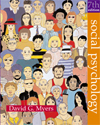 |  Social Psychology, 7/e David G Myers,
Hope College
Prejudice: Disliking Others
Learning ObjectivesAfter completing your study of this chapter you should be able to:
1.Distinguish between prejudice and discrimination. |
 |  |  | 2.Trace recent trends in racial and gender prejudice in the United States. |
 |  |  | 3.Explain how unequal status, self-fulfilling prophecy, and the mere formation of groups foster prejudice. |
 |  |  | 4.Demonstrate how prejudice is maintained through conformity and institutional supports. |
 |  |  | 5.Explain the scapegoat theory of prejudice and the personality dynamics of authoritarianism. |
 |  |  | 6.Show how stereotypes can be a by-product of our normal thinking processes. |
 |  |  | 7.Describe the just world phenomenon. |
 |  |  | 8.Identify cognitive consequences of stereotypes. |
|



 2002 McGraw-Hill Higher Education
2002 McGraw-Hill Higher Education